What’s The Value Of A Real Dinosaur Tooth? The intrigue surrounding a real dinosaur tooth is palpable, as it embodies the essence of a bygone world, a piece of the puzzle in the grand narrative of life on Earth. The value is not only gauged by its rarity and condition but also by the insights it provides into the dietary habits and lifestyles of these magnificent beasts. As paleontologists meticulously study each serration, each wear pattern, they unravel the intricate web of prehistoric existence, offering us a glimpse into an age where these titans were the unchallenged masters of the land.

What’s the Value of a Real Dinosaur Tooth?
The cost of a dinosaur tooth varies from $20 to a mid-range of $2000. Some cost $25,000 or more for a single tooth. The value depends a lot on the species of dinosaur and whether it is a single tooth or attached to a jawbone. It also depends on their size, density, composition, and weight. A T-Rex tooth is the most expensive dinosaur tooth.
The value determination of a dinosaur tooth hinges on numerous key factors. Primary among these are the tooth’s specific species origin, such as that of a Tyrannosaurus Rex or a Spinosaurus.
A tooth’s physical properties, including its size and the condition it has been preserved in, further refine its market value. Age is also a determinant; an older tooth hailing from the long-past dinosaur era holds more value due to its increased rarity.
The marketplace plays a critical role in shaping this value, influenced by interactions between stakeholders – buyers, sellers, and even fossil dealers. This market could range from traditional auction houses like Sotheby’s to digital platforms like eBay. Demand factors heavily into this equation, prompted by the interest of fossil collectors and esteemed institutions like the Smithsonian National Museum of Natural History.
Table of Contents
All parties involved remain ever vigilant for authenticity, to weed out replicas and maintain market integrity. Keeping these factors in mind, it is clear that the value of a real dinosaur tooth is not solely monetary.
Each tooth encapsulates a unique historical tapestry that holds intrinsic worth, veiling this seemingly simple sale process with layers of earth’s deep-seated history. This allure of owning a piece of ancient history only propels the value and demand for these relics higher.
Besides the large carnivore teeth like T-Rex or a Spinosaurus, there are herbivore dinosaurs that had teeth. These teeth were different in shape because they had a different purpose – grinding vegetation. Let’s take a look at both carnivore and herbivore dinosaur teeth and discover what elements make a particular tooth more valuable and also how to identify them.
How Much Does a T-Rex Tooth Cost? How Much Does a Spinosaurus Tooth Cost? Cost Level Considerations
By understanding what influences the cost of a dinosaur tooth, it will be easier to evaluate how much a dinosaur tooth would be worth. Carnivore and herbivore dinosaurs both had teeth but had different uses, and depending on the species of dinosaur, they also had different sizes and shapes. The cost levels are easier to figure out if we address these and a few other elements when it comes to dinosaur teeth.
Carnivore Dinosaur Tooth – The T-Rex
Some carnivores have two types of teeth, which are used for different purposes. The front set had the purpose of gripping and tearing the flesh of prey and, as such, were tightly packed. The back and side teeth were for crushing and grinding of the flesh. T-Rex was a giant predator of the late cretaceous period. Their skeletons have been found in multiple places around the world. Some of them have the skull and teeth in exceptional condition. These skeletons sell for millions of dollars.
In particular, one of the most complete T-Rex skeletons had full rows of teeth in the skull. There were approximately 30 pairs of teeth in this skull. The largest tooth was an incredible 12 inches (30.48cm) in length from root to tip. The complete skeleton sold for more than $8 million.
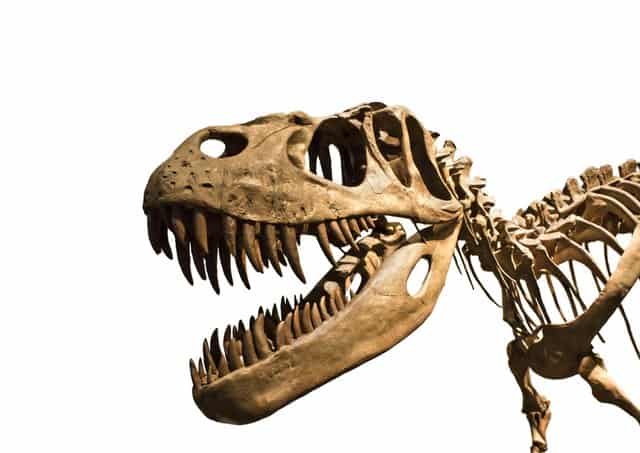
How much would a single T-rex tooth cost, if it wasn’t in the jawbone and completely separate? The world record for a single T-Rex tooth sold for approximately $45,000 (£36,000), which was found in excellent condition by a farmer. (Source)
Carnivore Dinosaur Tooth – The Spinosaurus
Spinosaurus, on the other hand, was a native of North Africa in the Cretaceous Period and a different type of carnivore. Paleontologist E. Stromer was the first to discover their fossils in late 1915. Sadly, it’s claimed that many of the fossils were destroyed during World War II, which may have held additional information about the dinosaurs.
The Spinosaurus was thought to be larger than the T-rex and other carnivores. The skulls of Spinosaurus were just like modern crocodiles. They had a snout mouth which had contained 32 pairs of teeth (singly 64). They were 1 to 3 inches long (2.54cm to 7.62cm), but if we include length from the root, they became as long as 8 inches (20.32cm). A single Spinosaurus tooth is not as expensive as a T-Rex.
Herbivore Dinosaur Tooth
In contrast to carnivore teeth, let’s take a look at herbivore dinosaurs and differences in the value of a real dinosaur tooth.
Herbivore dinosaurs like the Hadrosaurus, a type of duck-billed dinosaur and ceratopsians as well as the giant sauropods like Diplodocus and Brachiosaurus were plant-eaters. These dinosaurs used their teeth for different purposes, mostly for grinding vegetation and thus had different shapes and sizes. The shapes were flatter or were a kind of hollow and pointed tooth.
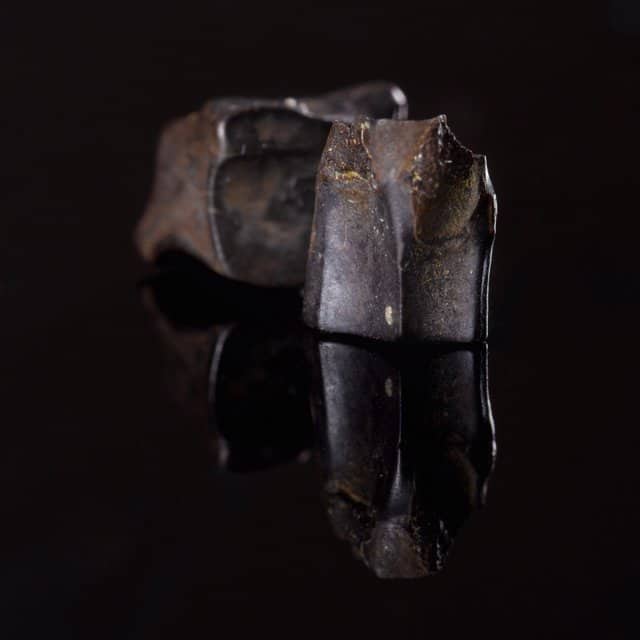
Despite the enormous size of the sauropods, their heads were comparatively small, and so the dimensions of their teeth were not in ratio to the size of the body.
Herbivore dinosaur teeth, such as the duck-billed dinosaur Hadrosaur, cost from approximately $20 to $1,000. Those on the jawbone where multiple teeth are set cost much more ranging from hundreds to thousands.
How Can You Tell If You Found a Real Dinosaur Tooth? Dinosaur Teeth Identification
The first dinosaurs appeared on earth 233 million years ago. There is a huge difference between today’s climate and vegetation compared to the Triassic, Jurassic, and Cretaceous periods. All that we have left of the creatures that lived during that time are the fossils that are left, and Paleontologists found fascinating fossils that include dinosaur teeth in skulls or individual teeth. Identifying them is a process of observation and comparison, which allows us to determine what kind of dinosaur tooth it is.
————————————————————————————————
Related Dinosaur Articles You Might Also Be Interested In:
Can You Buy and Own a Dinosaur Bone? The Law vs the Science
How Much Would A Real Dinosaur Egg Be Worth
Learn How Dinosaur Eggs Are Fossilized And Identified
————————————————————————————————
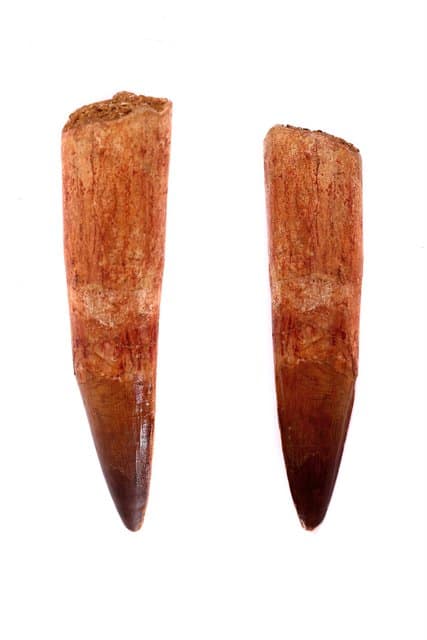
Broken Teeth, A Tooth with the Root and Without – Considerations for the Value of a Real Dinosaur Tooth
Generally, there are two main shapes in which tooth fossils are found. Some teeth have the root – most of the time still connected to the jawbone when the dinosaur died and teeth without the root. These teeth are broken teeth which were fell out or were broken off during accidents or the course of fighting or catching prey.
Naturally, it’s easier to identify teeth that are attached to a jawbone compared to those that are separated. Additionally, if the skull of the dinosaur is connected to arms, spines, and legs, the identification becomes easier to confirm as you can compare it to other skeletons.
Dinosaur Tooth Tissue Layers
Teeth are one of the most preserved parts of any fossil because they have an enamel layer surrounding the surface of the tooth, although not always extended to the root. That enamel layer doesn’t dissolve into minerals if the conditions stay favorable for a long time.
Dinosaur tooth identification and dinosaur dental anatomy have a history that dates back to the 1800s. Mary Ann Mentall and her husband, Dr. G. A. Mentall, identified the first dinosaur tooth (Iguanodon) and started studying the dental anatomy of dinosaurs in 1822. Thanks to their work and processes to identify dinosaur teeth, we have a reference point regarding dinosaur tooth tissue layers. There are five main tissue layers that we can find in a dinosaur tooth.
● Enamel – First, a robust, thin, and shiny coating that is typically the outermost layer of dinosaur’s tooth. This coating is known as enamel. This enamel contains a specific composition and structure that helps to identify teeth.
● Dentine – Second, Dentine present right under the enamel layer. A few tubes run through it, and it is quite a bigger layer then enamel.
● Cementum tissue it makes the root area of teeth. It consists of predominantly type I Collagen fibers that are another source of identification.
● Ligaments – which are mostly are found between the root and the cementum. Because that part has consisted of soft tissues, mostly it doesn’t find with fossils, some minerals just found in place of it.
● Alveolar Bone – This bone has a specific outlook.
All of these five tissues were the main elements that are the most helping things in identifying the value of a real dinosaur tooth. It follows that the more of the tissue layers that are still with the tooth, the easier it is to identify the species of dinosaur.
Along with them, some other behaviors like tooth growths and replacement patterns. Dinosaurs teeth fall during their life more than once, tooth attachments, and dental batteries (found layer by layer in many dinosaur’s teeth) have also been found.
What’s the Biggest Dinosaur Tooth Ever Found? Amazing Places Where Dinosaur Teeth Are Found
The Biggest Dinosaur Tooth
In Triassic, Jurassic, and Cretaceous periods hundreds of species dinosaurs lived. Each species has a specific type of tooth formation as well as features in the five layers of a tooth, not to mention the length and width of the tooth. There are teeth from a few centimeters to more than 10 inches (25.4cm) in length.
The biggest tooth found in the world up until now is 12 inches (30.48cm) long (including from tooth root to enamel), and this tooth belongs to the well-known species of T-Rex.
Most varieties of dinosaurs were found in countries like North America, Argentina, and China. Plant debris, sand, mud, rocks, and many other factors have kept these fossils alive.
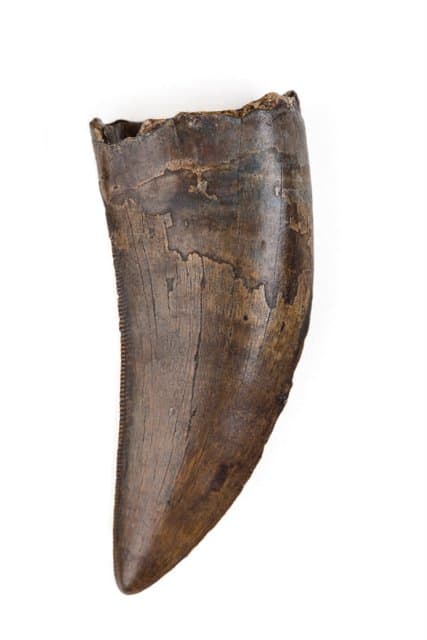
Tooth fossils are being discovered even more frequently today, and countries are announcing that the length of the tooth is breaking former records in their country.
● Japan has found meat-eating theropod dinosaur teeth, which are 3.2 inches (8.2cm) long and 1.1 inches (2.8cm) wide.
● Spain recently announced about another dinosaurs’ teeth which are, Allosaurid tooth, 3.9 inches (9.8cm) long deposited in Riodeva, Teruel.
● Portugal found a tooth from the same Allosaurid species as Spain, which was even longer, at 5 inches (12.7cm) long.
Famous Fossil Sites Known to Have Dinosaur Teeth
Although it’s not impossible to find a single dinosaur tooth, perhaps a more natural way is to search for dinosaur teeth in well-known fossil beds and sites. Many of the best dinosaur teeth fossils are connected to the jawbone. Often in areas where the skeleton is found, teeth separated from the jawbone are also found.
Here are a few fantastic places where many fossils are found, including teeth on the jawbone or separate.
●Canadian Dinosaur Provincial Park, Alberta, has won the credit of the highest number of species ever found from the same place. Currently, about 40 species from which about 500 single specimens have been recovered from this provincial park.
● Liaoning Province, China – Phillip Manning, a Paleontologist, names this place as the “Grave Secrets of Dinosaurs” because it is such a hotspot area for fossils.
● Gobi Desert, Mongolia – Considered a hotspot for dinosaur fossils
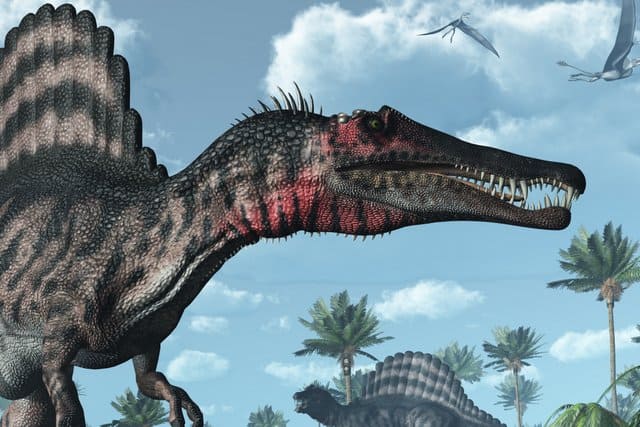
● Kem Kem Beds in Morocco – Among other dinosaurs, the Spinosaurus skeletons were found. Spinosaurus teeth are found in and around the Kem Kem Beds. (Source)
●Morrison Formation in Colorado – has layers of sedimentary rock and is one of the best places to find dinosaurs skeletons in the United States.
● Hell Creek Beds, Montana
●Denali National Park, Alaska
●National Monument, Nebraska
●Montour Fossil Pit, Pennsylvania
●Dinosaur National Monument, Utah
●Ghost Ranch, New Mexico
●Red Gulch Dinosaur Track Site, Wyoming
Final Thoughts
A dinosaur tooth, as well as a full set of teeth in a dinosaur skull, can set the imagination on fire, trying to imagine how it would look when it was alive. Incredibly, a dinosaur tooth from a T-Rex could be larger than your hand.
The great thing is that because of paleontology and the many dinosaur fossil sites, and there are many specimens of dinosaur skulls and dinosaur teeth to give us a better idea. And the pace of finding dinosaur fossils is not slowing down!
